Management Accounting: Customer Profitability & Transfer Pricing
VerifiedAdded on 2023/06/07
|8
|2153
|108
Report
AI Summary
This management accounting report analyzes customer profitability for Louise Fairbern's interior design business, covering two distribution channels: consulting and commercial window treatments. The analysis includes gross revenue, direct costs, overhead allocation, and discounts to determine net profit for each client. The report recommends strategies such as reducing discounts and re-evaluating unprofitable client relationships to mitigate losses. Additionally, the report explores transfer pricing scenarios for Super Chips, aiming to optimize profitability between divisions. The document concludes that the business is incurring losses and suggests implementing the recommendations to improve financial performance. This report also provides computations for transfer pricing and the impact of switching production processes, offering a comprehensive financial overview and strategic advice.

MANAGEMENT ACCOUNTING
SCENARIO 1
PART 1
Under Part 1 of stated scenario 1, one can see that it deals with deals with the determination
of the profits of an entrepreneur, Ms. LOUSIE FAIRBERN from her business which consist
of two distribution channels. The name of the distribution channels are a consulting business
wherein there exists two clientele Mr. Adams and Mr. Betz while the other consulting
business includes commercial window treatment business wherein there exists three clientele
namely Mr. Chatham, Mr.Dedham and Mr. Elm. . Further, it shall be pertinent to note that
Mr. Adams is provided a discount of 10% for luring customers from her competitors and a
5% discount to Mr.Elm for ensuring expedite payments. On the basis above detail a
simulation has been tabulated here-in-below stating profitability of the business :
Consumer Profitability (Amount in
AUD)
Sl.
N
o. Particulars Adams Betz
Chatha
m
Dedha
m Elm Total
1 Gross Revenue 234000 188800 357380
14784
0
7320
0 1001220
2 Direct Cost 147000 117200 218400
11572
0
5704
0 655360
3 Gross Profit 87000 71600 138980 32120
1616
0 345860
4 Indirect costs
-- Activity based
Overheads 85100 136160 221260
47099 38001 84127 34802
1723
1 221260
-Balance over head
allocation 27845 22466 42526 17592 8710 119140
5 Discount 23400 3660 27060
6 Net Profit -11344 11133 12326 -20274
-
1344
2 -21600
(Amount in
AUD)
Sl. No. Particulars Adams Betz Chatham Dedham Elm Total
1 Direct Cost 147000 117200 218400 115720 5704
0 655360
2 Indirect costs
- Activity based
Overheads 85100 136160 221260
SCENARIO 1
PART 1
Under Part 1 of stated scenario 1, one can see that it deals with deals with the determination
of the profits of an entrepreneur, Ms. LOUSIE FAIRBERN from her business which consist
of two distribution channels. The name of the distribution channels are a consulting business
wherein there exists two clientele Mr. Adams and Mr. Betz while the other consulting
business includes commercial window treatment business wherein there exists three clientele
namely Mr. Chatham, Mr.Dedham and Mr. Elm. . Further, it shall be pertinent to note that
Mr. Adams is provided a discount of 10% for luring customers from her competitors and a
5% discount to Mr.Elm for ensuring expedite payments. On the basis above detail a
simulation has been tabulated here-in-below stating profitability of the business :
Consumer Profitability (Amount in
AUD)
Sl.
N
o. Particulars Adams Betz
Chatha
m
Dedha
m Elm Total
1 Gross Revenue 234000 188800 357380
14784
0
7320
0 1001220
2 Direct Cost 147000 117200 218400
11572
0
5704
0 655360
3 Gross Profit 87000 71600 138980 32120
1616
0 345860
4 Indirect costs
-- Activity based
Overheads 85100 136160 221260
47099 38001 84127 34802
1723
1 221260
-Balance over head
allocation 27845 22466 42526 17592 8710 119140
5 Discount 23400 3660 27060
6 Net Profit -11344 11133 12326 -20274
-
1344
2 -21600
(Amount in
AUD)
Sl. No. Particulars Adams Betz Chatham Dedham Elm Total
1 Direct Cost 147000 117200 218400 115720 5704
0 655360
2 Indirect costs
- Activity based
Overheads 85100 136160 221260
Paraphrase This Document
Need a fresh take? Get an instant paraphrase of this document with our AI Paraphraser
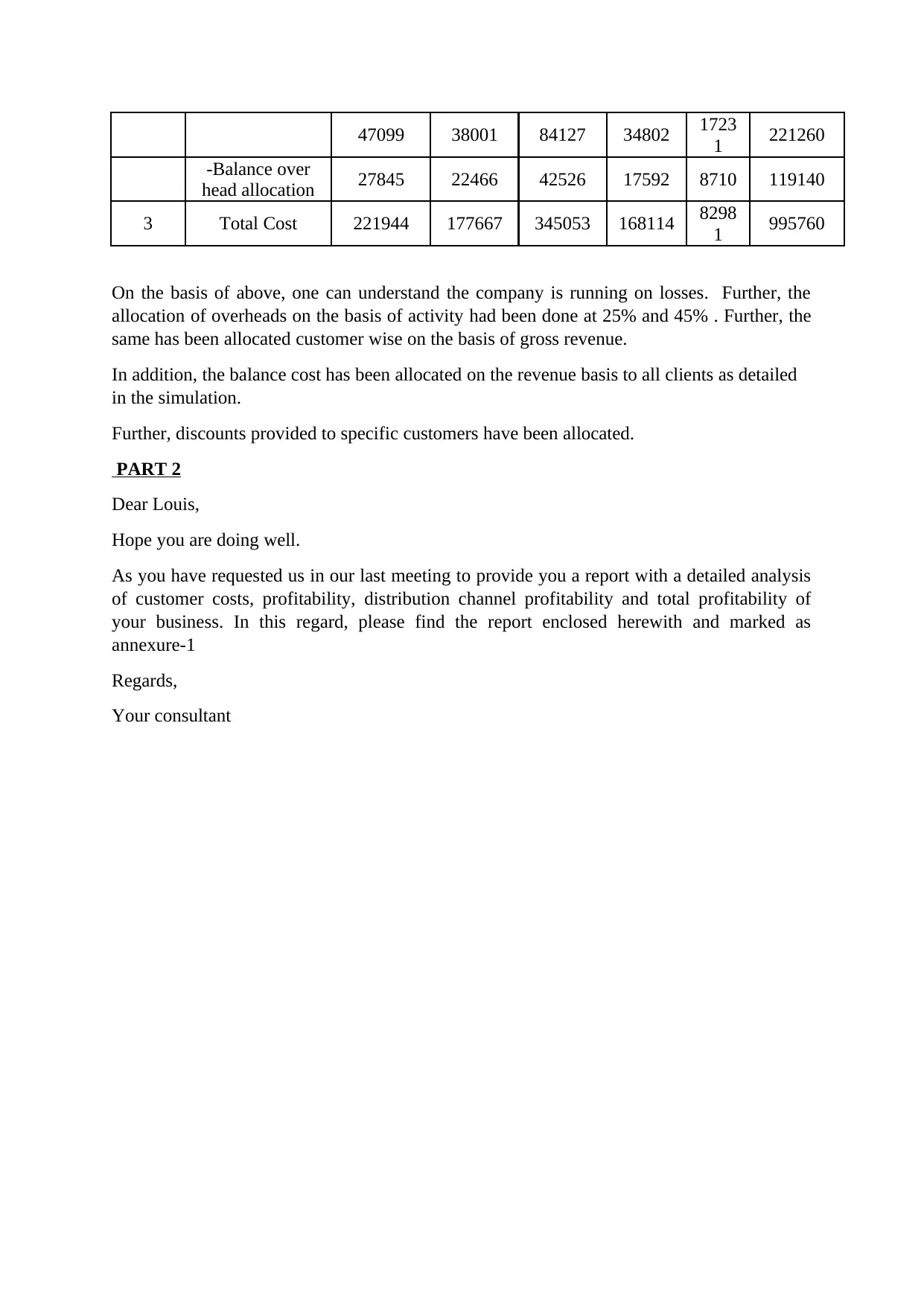
47099 38001 84127 34802 1723
1 221260
-Balance over
head allocation 27845 22466 42526 17592 8710 119140
3 Total Cost 221944 177667 345053 168114 8298
1 995760
On the basis of above, one can understand the company is running on losses. Further, the
allocation of overheads on the basis of activity had been done at 25% and 45% . Further, the
same has been allocated customer wise on the basis of gross revenue.
In addition, the balance cost has been allocated on the revenue basis to all clients as detailed
in the simulation.
Further, discounts provided to specific customers have been allocated.
PART 2
Dear Louis,
Hope you are doing well.
As you have requested us in our last meeting to provide you a report with a detailed analysis
of customer costs, profitability, distribution channel profitability and total profitability of
your business. In this regard, please find the report enclosed herewith and marked as
annexure-1
Regards,
Your consultant
1 221260
-Balance over
head allocation 27845 22466 42526 17592 8710 119140
3 Total Cost 221944 177667 345053 168114 8298
1 995760
On the basis of above, one can understand the company is running on losses. Further, the
allocation of overheads on the basis of activity had been done at 25% and 45% . Further, the
same has been allocated customer wise on the basis of gross revenue.
In addition, the balance cost has been allocated on the revenue basis to all clients as detailed
in the simulation.
Further, discounts provided to specific customers have been allocated.
PART 2
Dear Louis,
Hope you are doing well.
As you have requested us in our last meeting to provide you a report with a detailed analysis
of customer costs, profitability, distribution channel profitability and total profitability of
your business. In this regard, please find the report enclosed herewith and marked as
annexure-1
Regards,
Your consultant

Annexure-1
Report on Louise Fairbern Business
Introduction
Louise Fairbern is an entrepreneur. Her business consists of two distribution channels. The
name of the distribution channels are a consulting business wherein there exists two clientele
Mr. Adams and Mr. Betz while the other consulting business includes commercial window
treatment business wherein there exists three clientele namely Mr. Chatham, Mr.Dedham
and Mr. Elm. . Further, it shall be pertinent to note that Mr. Adams is provided a discount of
10% for luring customers from her competitors and a 5% discount to Mr.Elm for ensuring
expedite payments.
Analysis
On the basis of details provided above, a detailed analysis was conducted with emphasis on
cost associated with each individual client and revenue generated from such client. A detailed
simulation has been provided here-in-below wherein the cost and profit from each client has
been tabulated.
(Amount in
AUD)
Sl.
No. Particulars Adams Betz Chatham Dedham Elm Total
1
Gross
Revenue 234000 188800 357380 147840 73200 1001220
2 Direct Cost 147000 117200 218400 115720 57040 655360
3 Gross Profit 87000 71600 138980 32120 16160 345860
4
Indirect
costs
-Overheads 85100 136160 221260
47099 38001 84127 34802 17231 221260
-Balance
over head
allocation 27845 22466 42526 17592 8710 119140
5 Discount 23400 3660 27060
6 Net Profit -11344 11133 12326 -20274 -13442 -21600
7
Business
wise result -211 -21389 -21600
Report on Louise Fairbern Business
Introduction
Louise Fairbern is an entrepreneur. Her business consists of two distribution channels. The
name of the distribution channels are a consulting business wherein there exists two clientele
Mr. Adams and Mr. Betz while the other consulting business includes commercial window
treatment business wherein there exists three clientele namely Mr. Chatham, Mr.Dedham
and Mr. Elm. . Further, it shall be pertinent to note that Mr. Adams is provided a discount of
10% for luring customers from her competitors and a 5% discount to Mr.Elm for ensuring
expedite payments.
Analysis
On the basis of details provided above, a detailed analysis was conducted with emphasis on
cost associated with each individual client and revenue generated from such client. A detailed
simulation has been provided here-in-below wherein the cost and profit from each client has
been tabulated.
(Amount in
AUD)
Sl.
No. Particulars Adams Betz Chatham Dedham Elm Total
1
Gross
Revenue 234000 188800 357380 147840 73200 1001220
2 Direct Cost 147000 117200 218400 115720 57040 655360
3 Gross Profit 87000 71600 138980 32120 16160 345860
4
Indirect
costs
-Overheads 85100 136160 221260
47099 38001 84127 34802 17231 221260
-Balance
over head
allocation 27845 22466 42526 17592 8710 119140
5 Discount 23400 3660 27060
6 Net Profit -11344 11133 12326 -20274 -13442 -21600
7
Business
wise result -211 -21389 -21600
⊘ This is a preview!⊘
Do you want full access?
Subscribe today to unlock all pages.

Trusted by 1+ million students worldwide
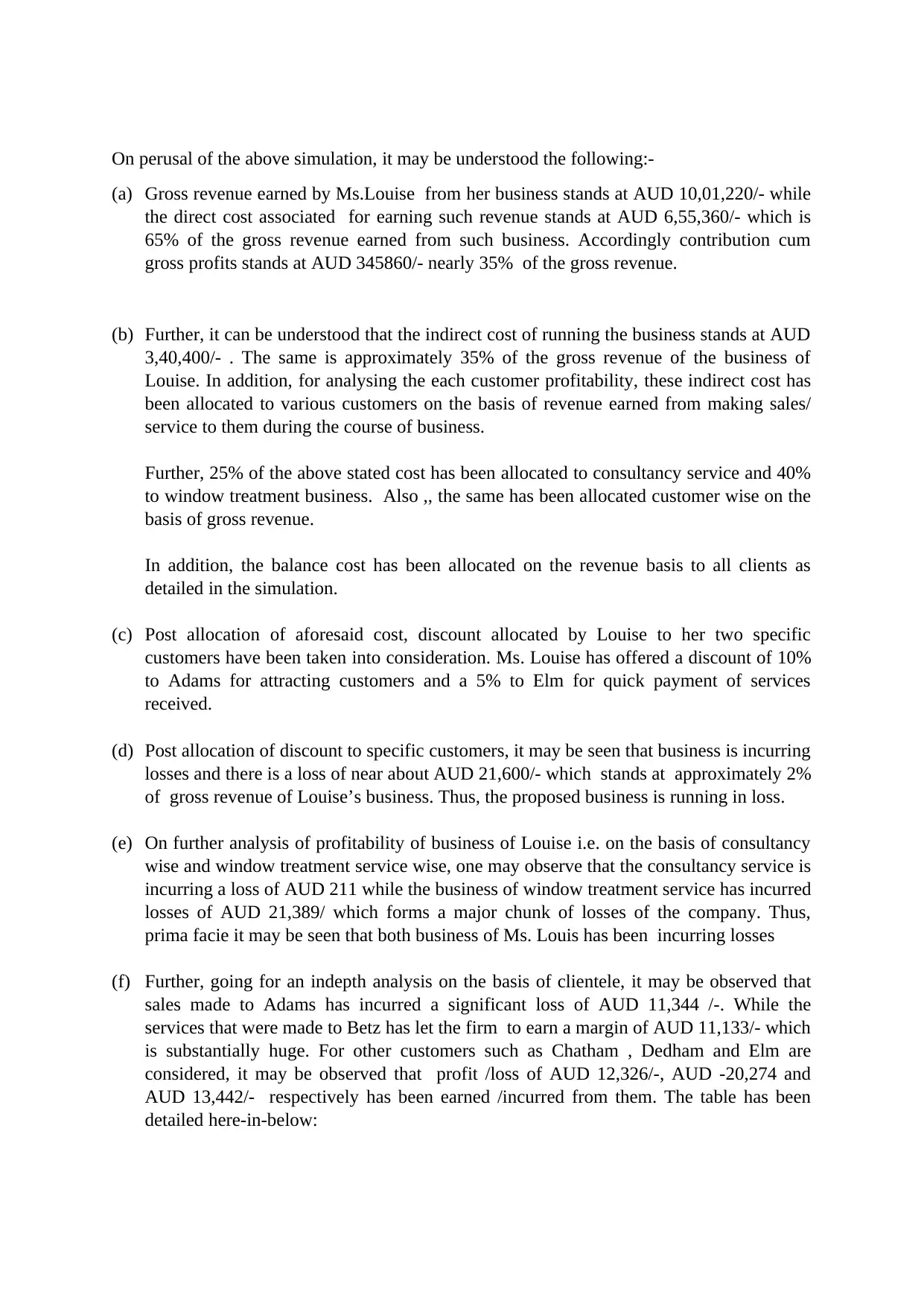
On perusal of the above simulation, it may be understood the following:-
(a) Gross revenue earned by Ms.Louise from her business stands at AUD 10,01,220/- while
the direct cost associated for earning such revenue stands at AUD 6,55,360/- which is
65% of the gross revenue earned from such business. Accordingly contribution cum
gross profits stands at AUD 345860/- nearly 35% of the gross revenue.
(b) Further, it can be understood that the indirect cost of running the business stands at AUD
3,40,400/- . The same is approximately 35% of the gross revenue of the business of
Louise. In addition, for analysing the each customer profitability, these indirect cost has
been allocated to various customers on the basis of revenue earned from making sales/
service to them during the course of business.
Further, 25% of the above stated cost has been allocated to consultancy service and 40%
to window treatment business. Also ,, the same has been allocated customer wise on the
basis of gross revenue.
In addition, the balance cost has been allocated on the revenue basis to all clients as
detailed in the simulation.
(c) Post allocation of aforesaid cost, discount allocated by Louise to her two specific
customers have been taken into consideration. Ms. Louise has offered a discount of 10%
to Adams for attracting customers and a 5% to Elm for quick payment of services
received.
(d) Post allocation of discount to specific customers, it may be seen that business is incurring
losses and there is a loss of near about AUD 21,600/- which stands at approximately 2%
of gross revenue of Louise’s business. Thus, the proposed business is running in loss.
(e) On further analysis of profitability of business of Louise i.e. on the basis of consultancy
wise and window treatment service wise, one may observe that the consultancy service is
incurring a loss of AUD 211 while the business of window treatment service has incurred
losses of AUD 21,389/ which forms a major chunk of losses of the company. Thus,
prima facie it may be seen that both business of Ms. Louis has been incurring losses
(f) Further, going for an indepth analysis on the basis of clientele, it may be observed that
sales made to Adams has incurred a significant loss of AUD 11,344 /-. While the
services that were made to Betz has let the firm to earn a margin of AUD 11,133/- which
is substantially huge. For other customers such as Chatham , Dedham and Elm are
considered, it may be observed that profit /loss of AUD 12,326/-, AUD -20,274 and
AUD 13,442/- respectively has been earned /incurred from them. The table has been
detailed here-in-below:
(a) Gross revenue earned by Ms.Louise from her business stands at AUD 10,01,220/- while
the direct cost associated for earning such revenue stands at AUD 6,55,360/- which is
65% of the gross revenue earned from such business. Accordingly contribution cum
gross profits stands at AUD 345860/- nearly 35% of the gross revenue.
(b) Further, it can be understood that the indirect cost of running the business stands at AUD
3,40,400/- . The same is approximately 35% of the gross revenue of the business of
Louise. In addition, for analysing the each customer profitability, these indirect cost has
been allocated to various customers on the basis of revenue earned from making sales/
service to them during the course of business.
Further, 25% of the above stated cost has been allocated to consultancy service and 40%
to window treatment business. Also ,, the same has been allocated customer wise on the
basis of gross revenue.
In addition, the balance cost has been allocated on the revenue basis to all clients as
detailed in the simulation.
(c) Post allocation of aforesaid cost, discount allocated by Louise to her two specific
customers have been taken into consideration. Ms. Louise has offered a discount of 10%
to Adams for attracting customers and a 5% to Elm for quick payment of services
received.
(d) Post allocation of discount to specific customers, it may be seen that business is incurring
losses and there is a loss of near about AUD 21,600/- which stands at approximately 2%
of gross revenue of Louise’s business. Thus, the proposed business is running in loss.
(e) On further analysis of profitability of business of Louise i.e. on the basis of consultancy
wise and window treatment service wise, one may observe that the consultancy service is
incurring a loss of AUD 211 while the business of window treatment service has incurred
losses of AUD 21,389/ which forms a major chunk of losses of the company. Thus,
prima facie it may be seen that both business of Ms. Louis has been incurring losses
(f) Further, going for an indepth analysis on the basis of clientele, it may be observed that
sales made to Adams has incurred a significant loss of AUD 11,344 /-. While the
services that were made to Betz has let the firm to earn a margin of AUD 11,133/- which
is substantially huge. For other customers such as Chatham , Dedham and Elm are
considered, it may be observed that profit /loss of AUD 12,326/-, AUD -20,274 and
AUD 13,442/- respectively has been earned /incurred from them. The table has been
detailed here-in-below:
Paraphrase This Document
Need a fresh take? Get an instant paraphrase of this document with our AI Paraphraser
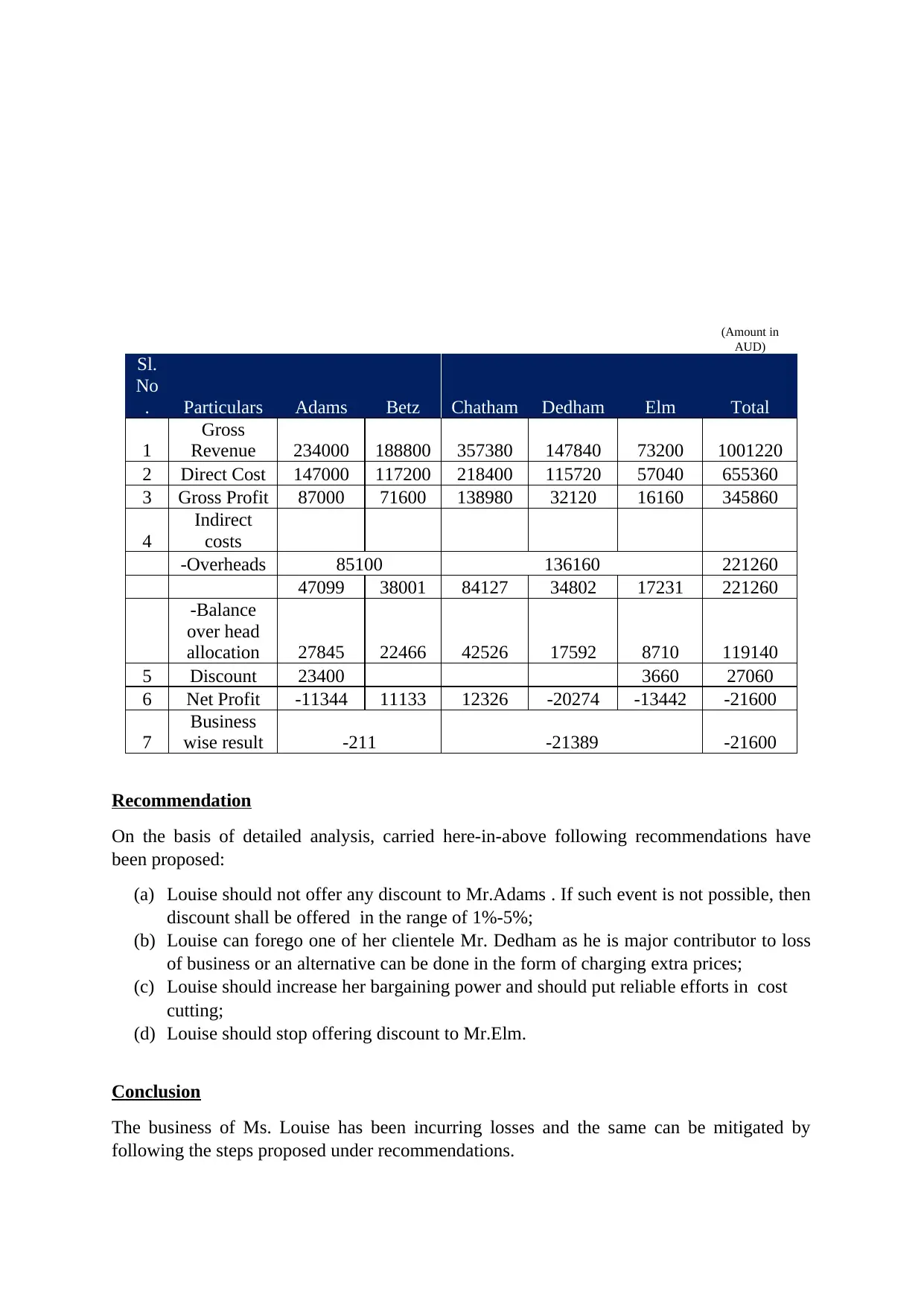
(Amount in
AUD)
Sl.
No
. Particulars Adams Betz Chatham Dedham Elm Total
1
Gross
Revenue 234000 188800 357380 147840 73200 1001220
2 Direct Cost 147000 117200 218400 115720 57040 655360
3 Gross Profit 87000 71600 138980 32120 16160 345860
4
Indirect
costs
-Overheads 85100 136160 221260
47099 38001 84127 34802 17231 221260
-Balance
over head
allocation 27845 22466 42526 17592 8710 119140
5 Discount 23400 3660 27060
6 Net Profit -11344 11133 12326 -20274 -13442 -21600
7
Business
wise result -211 -21389 -21600
Recommendation
On the basis of detailed analysis, carried here-in-above following recommendations have
been proposed:
(a) Louise should not offer any discount to Mr.Adams . If such event is not possible, then
discount shall be offered in the range of 1%-5%;
(b) Louise can forego one of her clientele Mr. Dedham as he is major contributor to loss
of business or an alternative can be done in the form of charging extra prices;
(c) Louise should increase her bargaining power and should put reliable efforts in cost
cutting;
(d) Louise should stop offering discount to Mr.Elm.
Conclusion
The business of Ms. Louise has been incurring losses and the same can be mitigated by
following the steps proposed under recommendations.
AUD)
Sl.
No
. Particulars Adams Betz Chatham Dedham Elm Total
1
Gross
Revenue 234000 188800 357380 147840 73200 1001220
2 Direct Cost 147000 117200 218400 115720 57040 655360
3 Gross Profit 87000 71600 138980 32120 16160 345860
4
Indirect
costs
-Overheads 85100 136160 221260
47099 38001 84127 34802 17231 221260
-Balance
over head
allocation 27845 22466 42526 17592 8710 119140
5 Discount 23400 3660 27060
6 Net Profit -11344 11133 12326 -20274 -13442 -21600
7
Business
wise result -211 -21389 -21600
Recommendation
On the basis of detailed analysis, carried here-in-above following recommendations have
been proposed:
(a) Louise should not offer any discount to Mr.Adams . If such event is not possible, then
discount shall be offered in the range of 1%-5%;
(b) Louise can forego one of her clientele Mr. Dedham as he is major contributor to loss
of business or an alternative can be done in the form of charging extra prices;
(c) Louise should increase her bargaining power and should put reliable efforts in cost
cutting;
(d) Louise should stop offering discount to Mr.Elm.
Conclusion
The business of Ms. Louise has been incurring losses and the same can be mitigated by
following the steps proposed under recommendations.
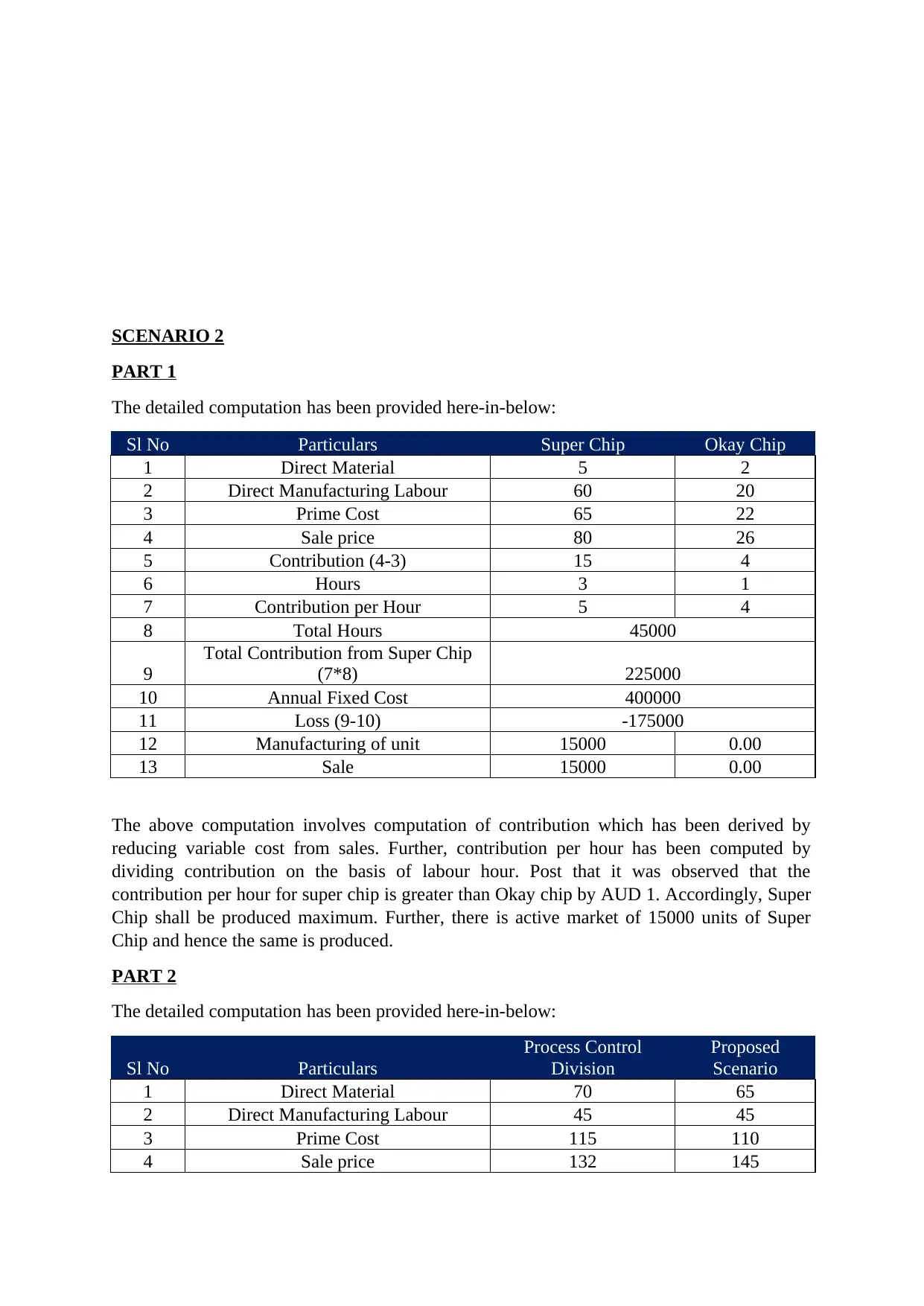
SCENARIO 2
PART 1
The detailed computation has been provided here-in-below:
Sl No Particulars Super Chip Okay Chip
1 Direct Material 5 2
2 Direct Manufacturing Labour 60 20
3 Prime Cost 65 22
4 Sale price 80 26
5 Contribution (4-3) 15 4
6 Hours 3 1
7 Contribution per Hour 5 4
8 Total Hours 45000
9
Total Contribution from Super Chip
(7*8) 225000
10 Annual Fixed Cost 400000
11 Loss (9-10) -175000
12 Manufacturing of unit 15000 0.00
13 Sale 15000 0.00
The above computation involves computation of contribution which has been derived by
reducing variable cost from sales. Further, contribution per hour has been computed by
dividing contribution on the basis of labour hour. Post that it was observed that the
contribution per hour for super chip is greater than Okay chip by AUD 1. Accordingly, Super
Chip shall be produced maximum. Further, there is active market of 15000 units of Super
Chip and hence the same is produced.
PART 2
The detailed computation has been provided here-in-below:
Sl No Particulars
Process Control
Division
Proposed
Scenario
1 Direct Material 70 65
2 Direct Manufacturing Labour 45 45
3 Prime Cost 115 110
4 Sale price 132 145
PART 1
The detailed computation has been provided here-in-below:
Sl No Particulars Super Chip Okay Chip
1 Direct Material 5 2
2 Direct Manufacturing Labour 60 20
3 Prime Cost 65 22
4 Sale price 80 26
5 Contribution (4-3) 15 4
6 Hours 3 1
7 Contribution per Hour 5 4
8 Total Hours 45000
9
Total Contribution from Super Chip
(7*8) 225000
10 Annual Fixed Cost 400000
11 Loss (9-10) -175000
12 Manufacturing of unit 15000 0.00
13 Sale 15000 0.00
The above computation involves computation of contribution which has been derived by
reducing variable cost from sales. Further, contribution per hour has been computed by
dividing contribution on the basis of labour hour. Post that it was observed that the
contribution per hour for super chip is greater than Okay chip by AUD 1. Accordingly, Super
Chip shall be produced maximum. Further, there is active market of 15000 units of Super
Chip and hence the same is produced.
PART 2
The detailed computation has been provided here-in-below:
Sl No Particulars
Process Control
Division
Proposed
Scenario
1 Direct Material 70 65
2 Direct Manufacturing Labour 45 45
3 Prime Cost 115 110
4 Sale price 132 145
⊘ This is a preview!⊘
Do you want full access?
Subscribe today to unlock all pages.

Trusted by 1+ million students worldwide
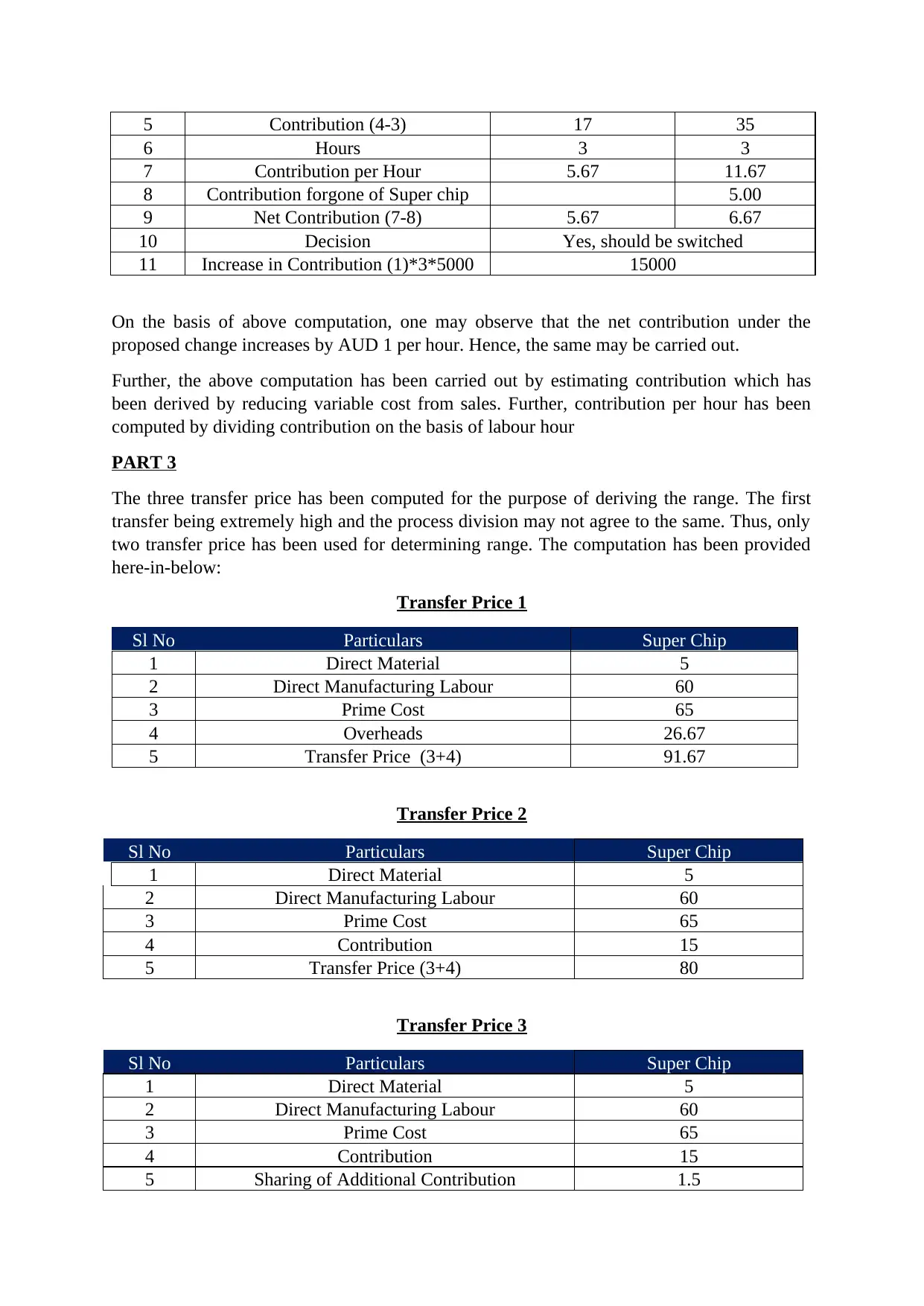
5 Contribution (4-3) 17 35
6 Hours 3 3
7 Contribution per Hour 5.67 11.67
8 Contribution forgone of Super chip 5.00
9 Net Contribution (7-8) 5.67 6.67
10 Decision Yes, should be switched
11 Increase in Contribution (1)*3*5000 15000
On the basis of above computation, one may observe that the net contribution under the
proposed change increases by AUD 1 per hour. Hence, the same may be carried out.
Further, the above computation has been carried out by estimating contribution which has
been derived by reducing variable cost from sales. Further, contribution per hour has been
computed by dividing contribution on the basis of labour hour
PART 3
The three transfer price has been computed for the purpose of deriving the range. The first
transfer being extremely high and the process division may not agree to the same. Thus, only
two transfer price has been used for determining range. The computation has been provided
here-in-below:
Transfer Price 1
Sl No Particulars Super Chip
1 Direct Material 5
2 Direct Manufacturing Labour 60
3 Prime Cost 65
4 Overheads 26.67
5 Transfer Price (3+4) 91.67
Transfer Price 2
Sl No Particulars Super Chip
1 Direct Material 5
2 Direct Manufacturing Labour 60
3 Prime Cost 65
4 Contribution 15
5 Transfer Price (3+4) 80
Transfer Price 3
Sl No Particulars Super Chip
1 Direct Material 5
2 Direct Manufacturing Labour 60
3 Prime Cost 65
4 Contribution 15
5 Sharing of Additional Contribution 1.5
6 Hours 3 3
7 Contribution per Hour 5.67 11.67
8 Contribution forgone of Super chip 5.00
9 Net Contribution (7-8) 5.67 6.67
10 Decision Yes, should be switched
11 Increase in Contribution (1)*3*5000 15000
On the basis of above computation, one may observe that the net contribution under the
proposed change increases by AUD 1 per hour. Hence, the same may be carried out.
Further, the above computation has been carried out by estimating contribution which has
been derived by reducing variable cost from sales. Further, contribution per hour has been
computed by dividing contribution on the basis of labour hour
PART 3
The three transfer price has been computed for the purpose of deriving the range. The first
transfer being extremely high and the process division may not agree to the same. Thus, only
two transfer price has been used for determining range. The computation has been provided
here-in-below:
Transfer Price 1
Sl No Particulars Super Chip
1 Direct Material 5
2 Direct Manufacturing Labour 60
3 Prime Cost 65
4 Overheads 26.67
5 Transfer Price (3+4) 91.67
Transfer Price 2
Sl No Particulars Super Chip
1 Direct Material 5
2 Direct Manufacturing Labour 60
3 Prime Cost 65
4 Contribution 15
5 Transfer Price (3+4) 80
Transfer Price 3
Sl No Particulars Super Chip
1 Direct Material 5
2 Direct Manufacturing Labour 60
3 Prime Cost 65
4 Contribution 15
5 Sharing of Additional Contribution 1.5
Paraphrase This Document
Need a fresh take? Get an instant paraphrase of this document with our AI Paraphraser
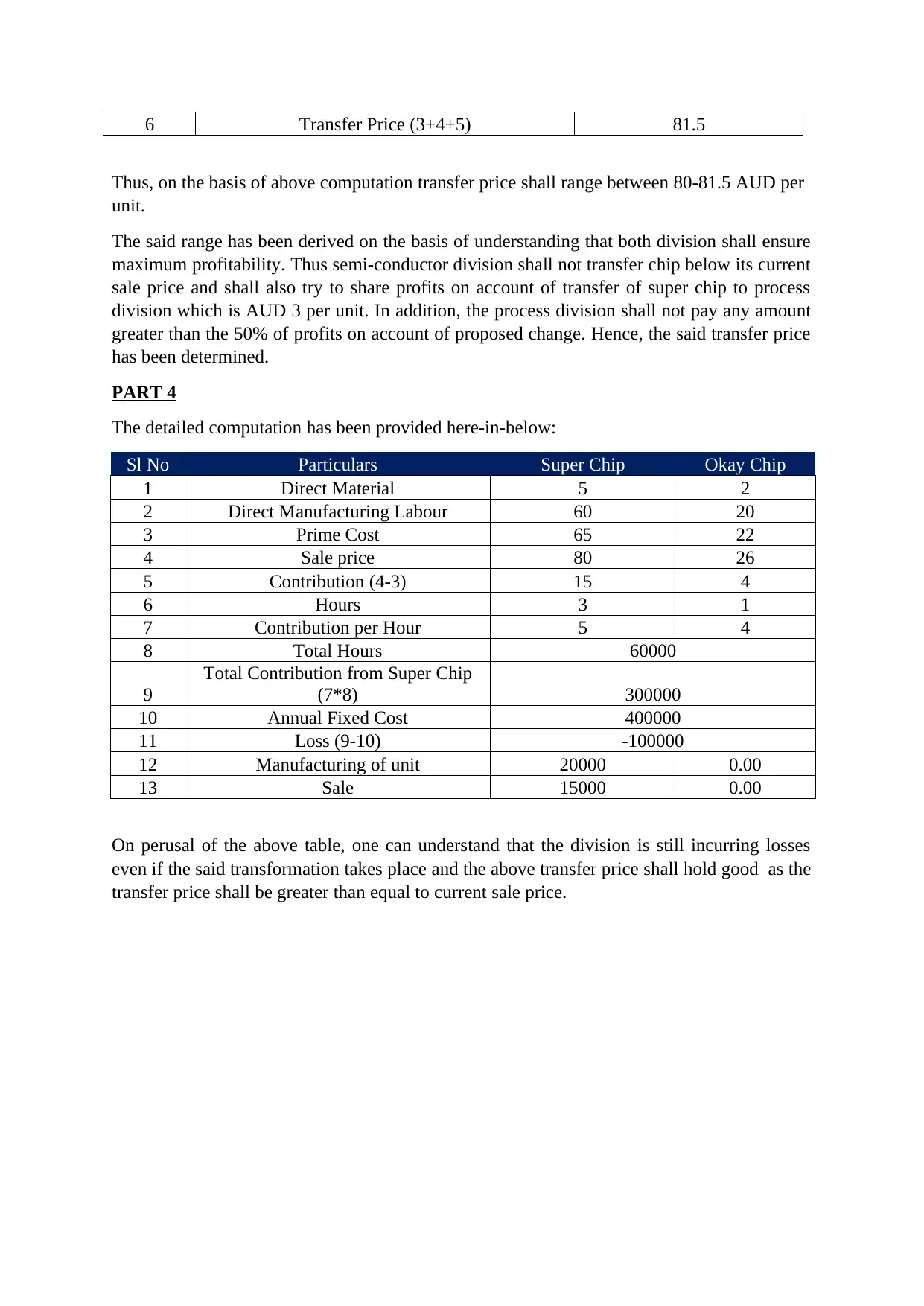
6 Transfer Price (3+4+5) 81.5
Thus, on the basis of above computation transfer price shall range between 80-81.5 AUD per
unit.
The said range has been derived on the basis of understanding that both division shall ensure
maximum profitability. Thus semi-conductor division shall not transfer chip below its current
sale price and shall also try to share profits on account of transfer of super chip to process
division which is AUD 3 per unit. In addition, the process division shall not pay any amount
greater than the 50% of profits on account of proposed change. Hence, the said transfer price
has been determined.
PART 4
The detailed computation has been provided here-in-below:
Sl No Particulars Super Chip Okay Chip
1 Direct Material 5 2
2 Direct Manufacturing Labour 60 20
3 Prime Cost 65 22
4 Sale price 80 26
5 Contribution (4-3) 15 4
6 Hours 3 1
7 Contribution per Hour 5 4
8 Total Hours 60000
9
Total Contribution from Super Chip
(7*8) 300000
10 Annual Fixed Cost 400000
11 Loss (9-10) -100000
12 Manufacturing of unit 20000 0.00
13 Sale 15000 0.00
On perusal of the above table, one can understand that the division is still incurring losses
even if the said transformation takes place and the above transfer price shall hold good as the
transfer price shall be greater than equal to current sale price.
Thus, on the basis of above computation transfer price shall range between 80-81.5 AUD per
unit.
The said range has been derived on the basis of understanding that both division shall ensure
maximum profitability. Thus semi-conductor division shall not transfer chip below its current
sale price and shall also try to share profits on account of transfer of super chip to process
division which is AUD 3 per unit. In addition, the process division shall not pay any amount
greater than the 50% of profits on account of proposed change. Hence, the said transfer price
has been determined.
PART 4
The detailed computation has been provided here-in-below:
Sl No Particulars Super Chip Okay Chip
1 Direct Material 5 2
2 Direct Manufacturing Labour 60 20
3 Prime Cost 65 22
4 Sale price 80 26
5 Contribution (4-3) 15 4
6 Hours 3 1
7 Contribution per Hour 5 4
8 Total Hours 60000
9
Total Contribution from Super Chip
(7*8) 300000
10 Annual Fixed Cost 400000
11 Loss (9-10) -100000
12 Manufacturing of unit 20000 0.00
13 Sale 15000 0.00
On perusal of the above table, one can understand that the division is still incurring losses
even if the said transformation takes place and the above transfer price shall hold good as the
transfer price shall be greater than equal to current sale price.
1 out of 8
Related Documents
Your All-in-One AI-Powered Toolkit for Academic Success.
+13062052269
info@desklib.com
Available 24*7 on WhatsApp / Email
![[object Object]](/_next/static/media/star-bottom.7253800d.svg)
Unlock your academic potential
© 2024 | Zucol Services PVT LTD | All rights reserved.




